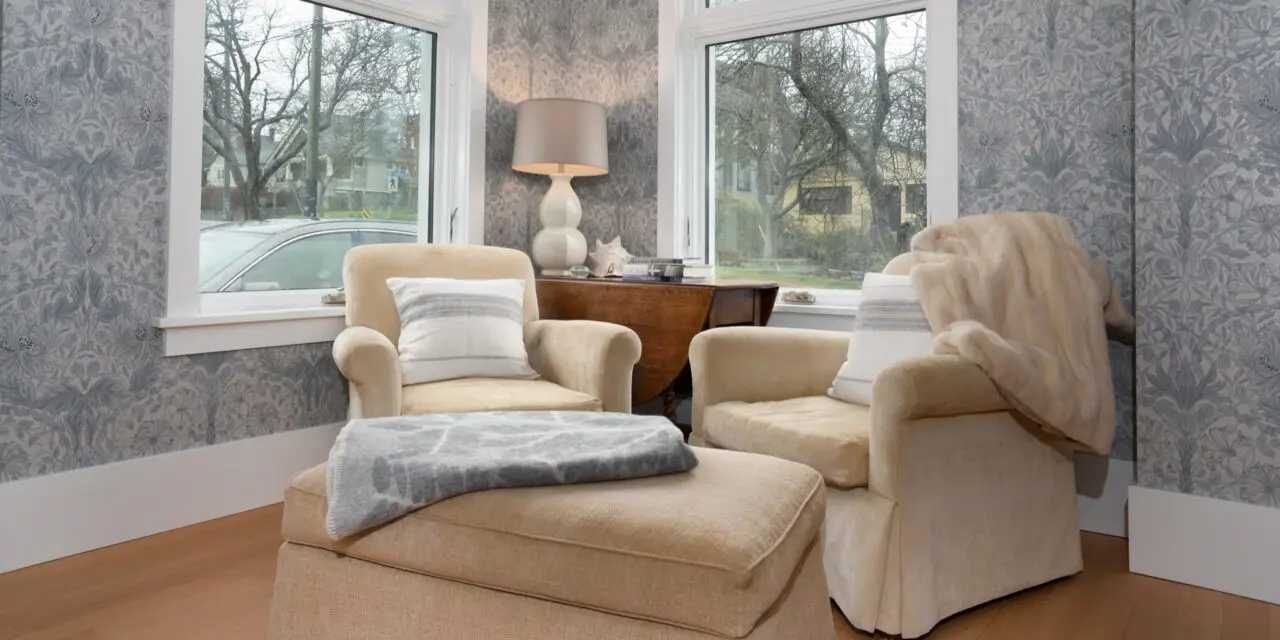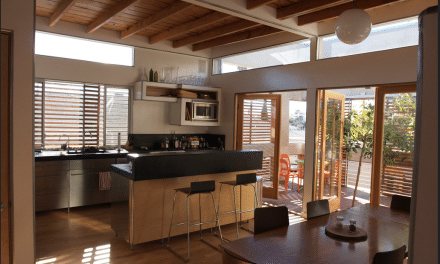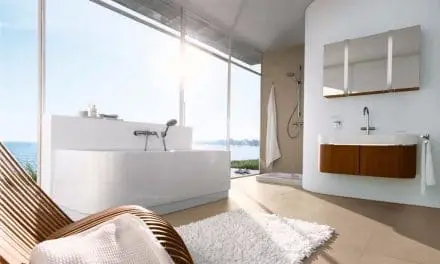All photos courtesy Wendy Littlefield
Wendy Littlefield pictures herself as a cheerleader for the environment: “I’m an activist at heart,” she says. Yale–educated (she studied architectural history), she is a realist who is passionate about what she undertakes. This sets the stage for a “senior gap year,” when Littlefield and her husband, Don Feinberg, decided to live somewhere new. They considered Spain and Portugal, but settled on British Columbia, Canada, as it was more accessible to family in Chicago. They sold their car and apartment and docked in Victoria. First impression: “It was so paradisiacal,” said Littlefield. “Like the South of France. The landscape was extraordinary with incredible trees. It was like all the places we’ve ever lived in and loved, rolled into one.”
Nine months later, pre-COVID, they found a stucco-clad, Arts and Crafts–style home (circa 1912), solidly built with first-growth fir, likely 300 years old. There was a big, gnarly Garry oak at the house at the top of the road, which Wendy said “spreads its arm over an old Indian path, a march of uninterrupted Garry oaks” all the way down to the Cordova Bay. “We thought [the house] had good bones, but it was very dated and the stucco was ugly.” Developers had been put off, as it was too costly to flip. Prospective homeowners wanted to tear it down. In fact, Littlefield and Feinberg were the only ones who proposed renovating.
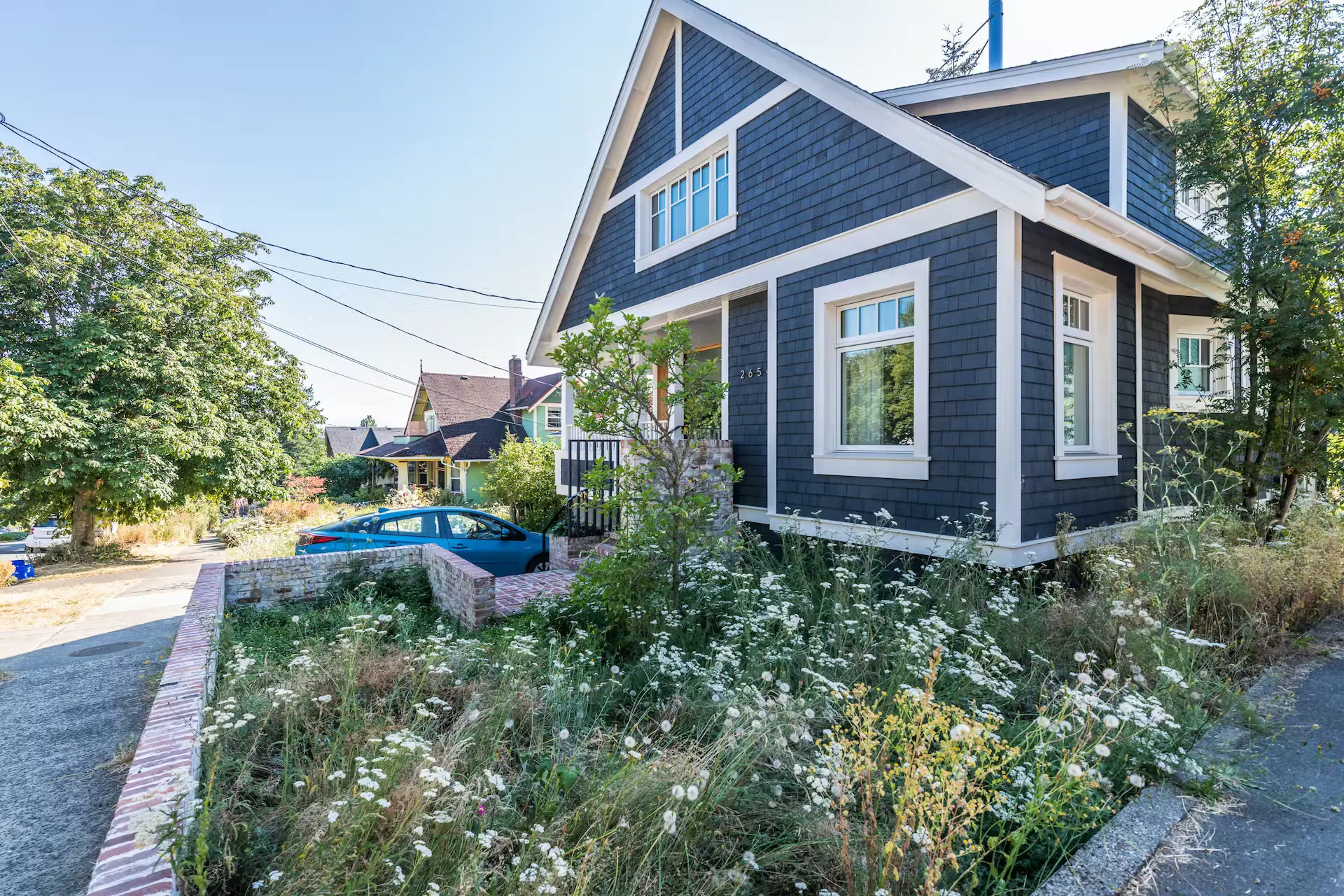
A rainwater-fed (via gutters) 800-gallon cistern irrigates the garden, with no grey water. Behind a low retaining wall made from recycled bricks, there is a magnolia surrounded by a wildflower meadow.
What is a green renovation?
Inspired to undertake a green remodel, the couple soon realized that this is an amorphous term. The same week they bought the house, they found architects David and Susan Scott, Scott & Scott Architects. Littlefield was a bit concerned that these very modern architects might “do something radical…. But they came back with what was the equivalent of a classic car renovation.”
Littlefield credits their daughter, Claire Feinberg, for introducing the concept of net zero. She recommended attending the International Living Futures Institute Conference in Seattle. It took a while before the couple found the right builder to execute the vision. Luckily, Taylor McCarthy of Frontera Homes focuses on sustainably minded new construction, renovations, and heritage restorations on Vancouver Island. But none of the assembled team had ever done a net zero home.
First thing to go: the oil tank. (That actually was a requirement for insurance.) Tests revealed no asbestos or other hazardous materials. Sigh of relief! Besides going to all-electric heat systems, they replaced all the glazing with triple pane, metal clad windows showing wood inside. A heat pump water heater, dual-zone heat pump, and heat recovery ventilator (HRV) handle mechanicals.
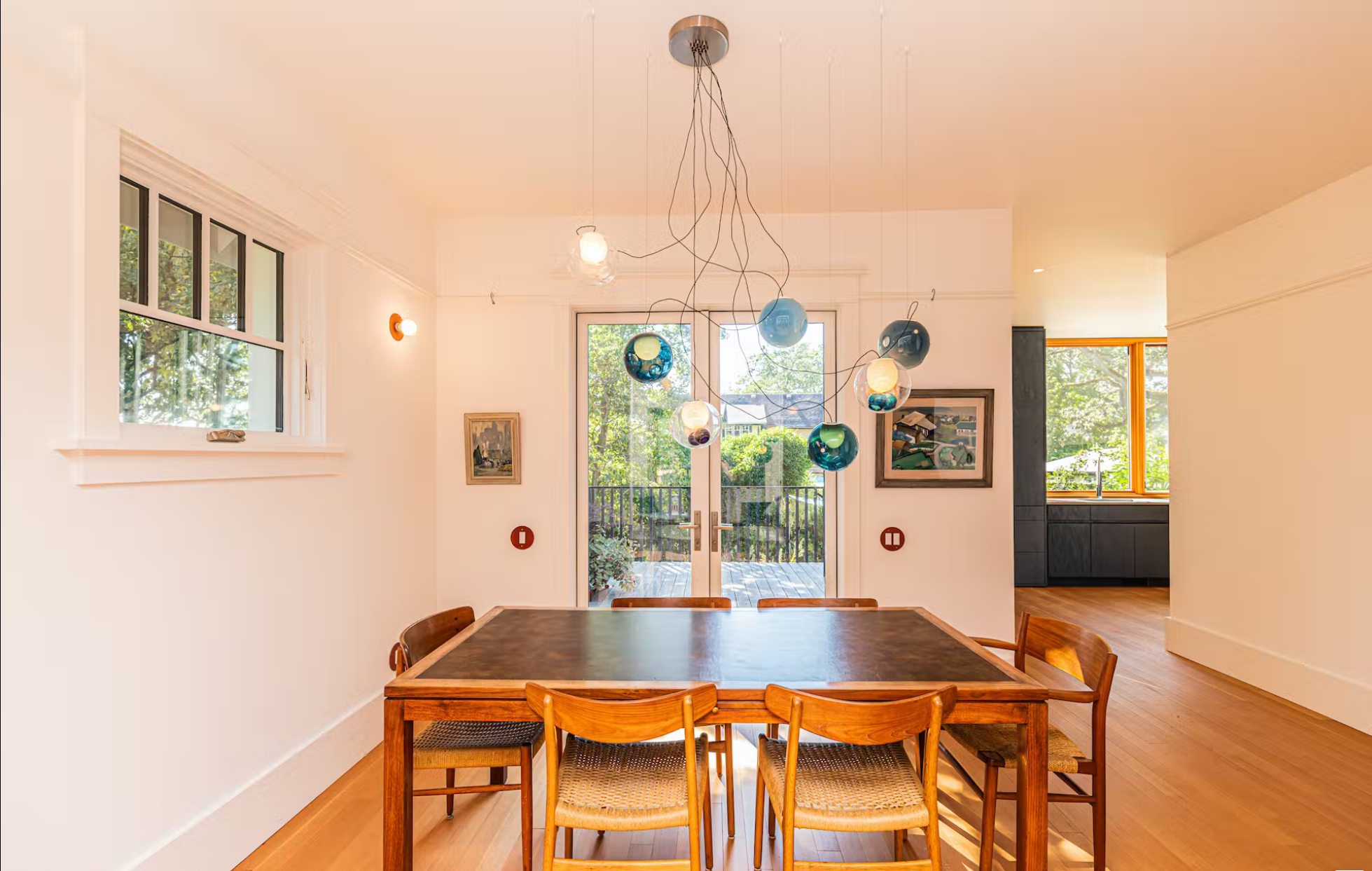
Wendy Littlefield snagged the hand blown glass Bocci light fixture as a factory second at the brand’s annual sale. The Hans Wegner dining chairs are a vintage treasure. Leather and steel light sconces were locally made in the architects’ workshop. Fishing line attached to octopus hooks holds art from high chair rails.

William Morris wallpaper in the family room nods to the Arts and Crafts history of the house. Anchoring the space is a Belgian Stüv high-performance wood stove, flanked by built-in bookcases.
Beauty, comfort, sustainability
But what to do with the stucco façade? The range in cost: $17,000 to $35,000. Removing the stucco would have created lots of waste. Instead they found a prototype for insulating and cladding over it. This ended up being more costly, but the decision did cut landfill waste by two-thirds.
Still, the builder worried that moisture would be trapped inside the wall cavities. So he found a thermometer-like apparatus that measures moisture. Mounted inside, north and south, the device still records zero moisture.
Wendy created a highly personal blog (netzerovictoria.com) to chronicle the process.
Here are just the facts:
- Ceilings upstairs were boosted from under 8 feet to 14+ feet.
- In the primary bedroom, the dormer was raised (requiring a variance permit) for a better view of the Olympic Mountains.
- A matching dormer was added on the north side to accommodate a new upstairs bath.
- Douglas fir now clads the ceiling on one side; original rafters and beams on the other.
- Roof rafters were extended to fit thicker insulation (which cuts down on heat loss). “Think of the house as wearing a thick parka,” explained Wendy. The rafter tails and roof provide a more substantial overhang.
- Instead of sheep’s wool, which was too expensive, Rockwool provides insulation. It comprises small recycled mineral fibers creating a sustainable and resilient alternative.
- A back room on the main level was transformed into another porch, expanding the dining room. This afforded an opportunity for a side room in the kitchen, with stunning views.
- The south roof was covered with solar panels.
- Recycled wood from the house and neighboring renovations found new uses.
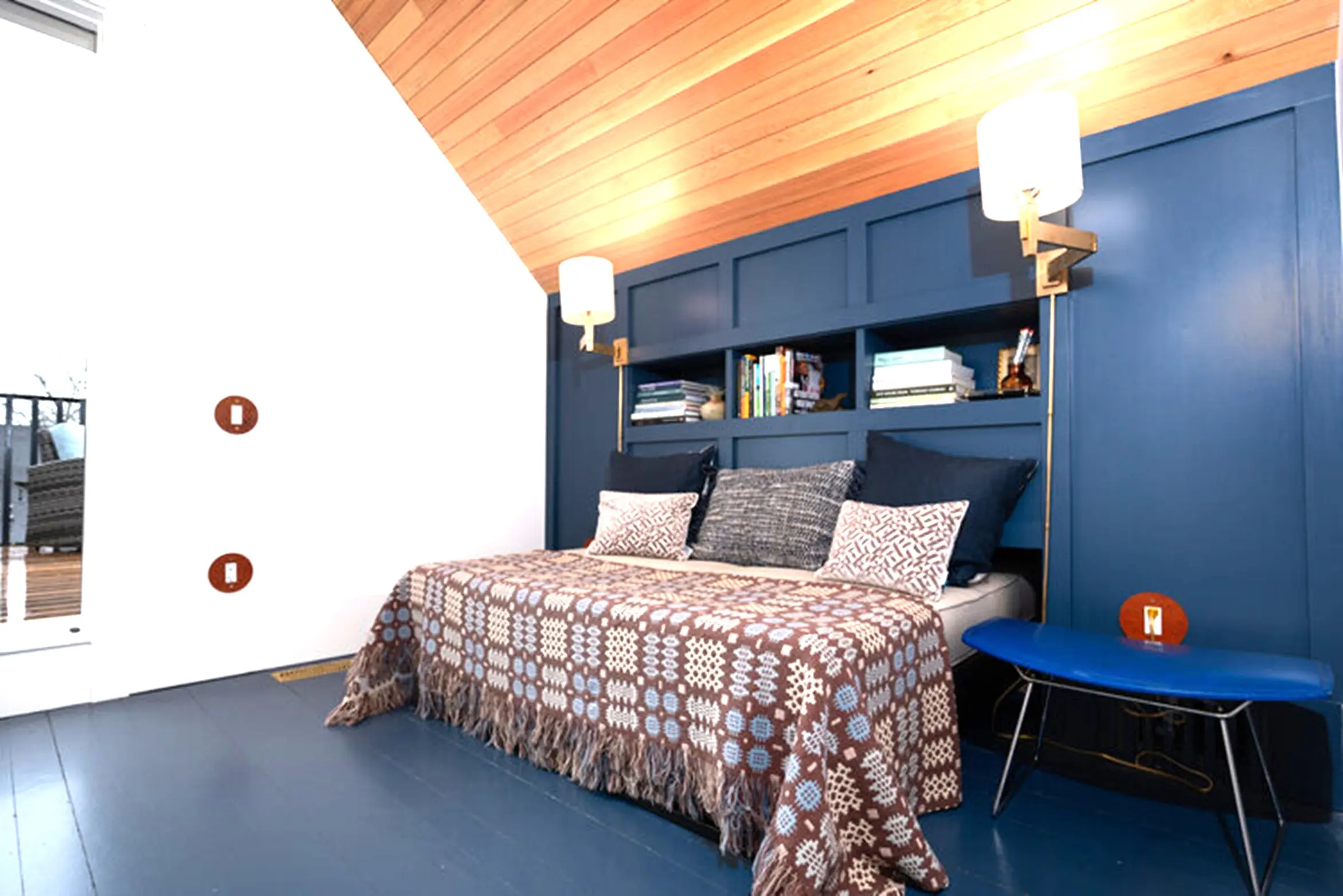
A local company made a hemp covered buttoned day bed for a sitting room which doubles as guest bedroom. The queen size bed slides into the wall like a sled, into a pocket created by a raised dormer that goes from 14 feet down to a foot. Meanwhile, the nontoxic mattress is natural latex, and a wool Welsh blanket is a vintage find.
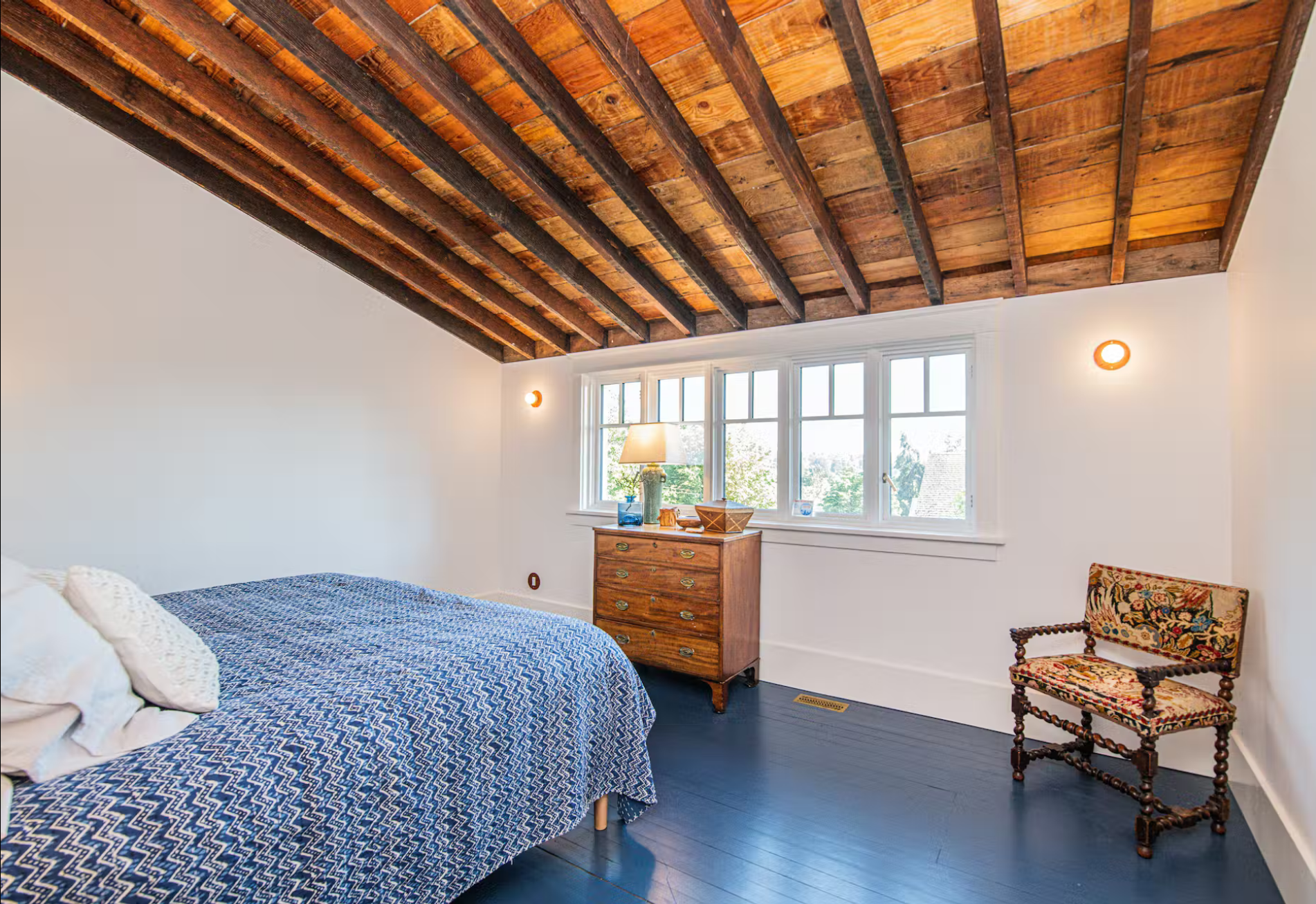
In a second bedroom, the ceiling was stripped down to the rafter and exposed post and beam. The needlepoint chair came from a local antique shop.
Difficult times
Because Victoria rests on an extension of the San Andreas fault , a shear wall reinforced with fir plywood provides structural integrity. “The Pacific Coast has additional seismic requirements,” explained architect David Scott. These have evolved over the 100 years of the home’s life. “While the house appears in many ways to be restored to its Shingle style, it also has been strengthened to meet contemporary standards and to be a more robust structure for the next 100 years.”
Another improvement: the foundation. “With an existing house,” said McCarthy, “20% or more of the energy loss comes through the basement foundation. Old homes didn’t insulate. This home is predominantly on top of limestone bedrock, so you can’t go down any further.
“Instead of adding from the bottom, we shrunk the size to about 200 square feet—about 150 for the conditioned mechanical room. Insulation is in the ceiling and walls, instead of the floor. There’s essentially a crawl space barely 6 feet tall, for bike storage.”
Much of the project took place during the pandemic, which for a time cut McCarthy’s construction team from seven to two. Also, travel restrictions separated Don and Wendy for 11 months—the longest they have ever been apart. But in the end, it was worth it.

Solar panels were part of a bulk buy purchased through the Fernwood Neighborhood Resource Group.

In front, recycled brick from the old fireplace and chimney was part of the mix used to build the distinctive stoop and planter. The front door (a reject from a local window and door company) is dressed with decoratively etched brass.
Another 100 years
“It’s really important to think about what the cultural value of a home is,” said McCarthy. “When something has the structural integrity of a home like this, and it’s aesthetically and architecturally pleasing to the eye, there’s a strong argument to keep it.”
Littlefield added: “We’re not architects…. Just average humans who want to do the right thing. It doesn’t have to be unaffordable.” Her mantra is, “If it’s not affordable, it’s not sustainable.”
Nevertheless, upfront costs of green building or remodeling and net zero homes can be daunting. David Scott argues that the costs really are comparable. “You may choose something that lasts 20 years instead of 100 years. [What] lasts 100 years may cost more upfront, but in the life of the house, replacing something four times versus not replacing it may [be equivalent].”
John Ho, community energy specialist with the city of Victoria said the Fernwood Net Zero retrofit project contributes to ambitious climate targets. “By switching away from an old fossil fuel heating system and by putting great effort into whole home energy efficiency upgrades… the project has redefined what the home of the future looks like.”
Wendy also wanted a balance between green tech and aesthetics. “We wanted it to be beautiful,” she said.
Scroll down to read more below the photo gallery

A new deck was fashioned from an add-on lopped off from the back. It’s the perfect spot for a harvest table to continue dining from indoors to outdoors.

A bath was added to the second floor. The spare design is punctuated by simple materials: Trikeenan tile from New York’s southern tier (clay country) and local Tlupana marble. All fixtures are energy efficient.
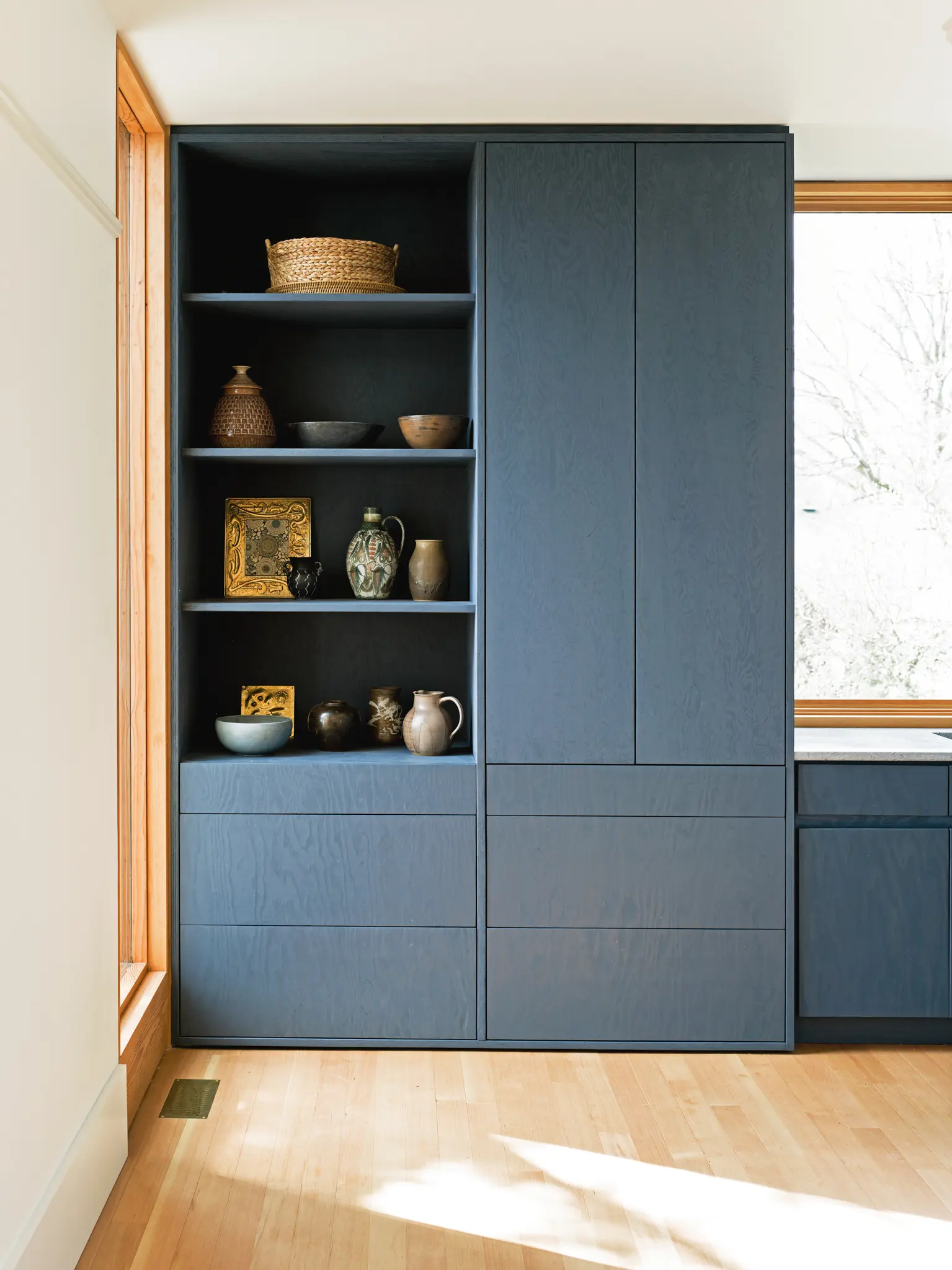
Local cabinetmaker Michael Ford crafted the built-in, a smaller version of an armoire from a German company that Wendy Littlefield fell in love with.
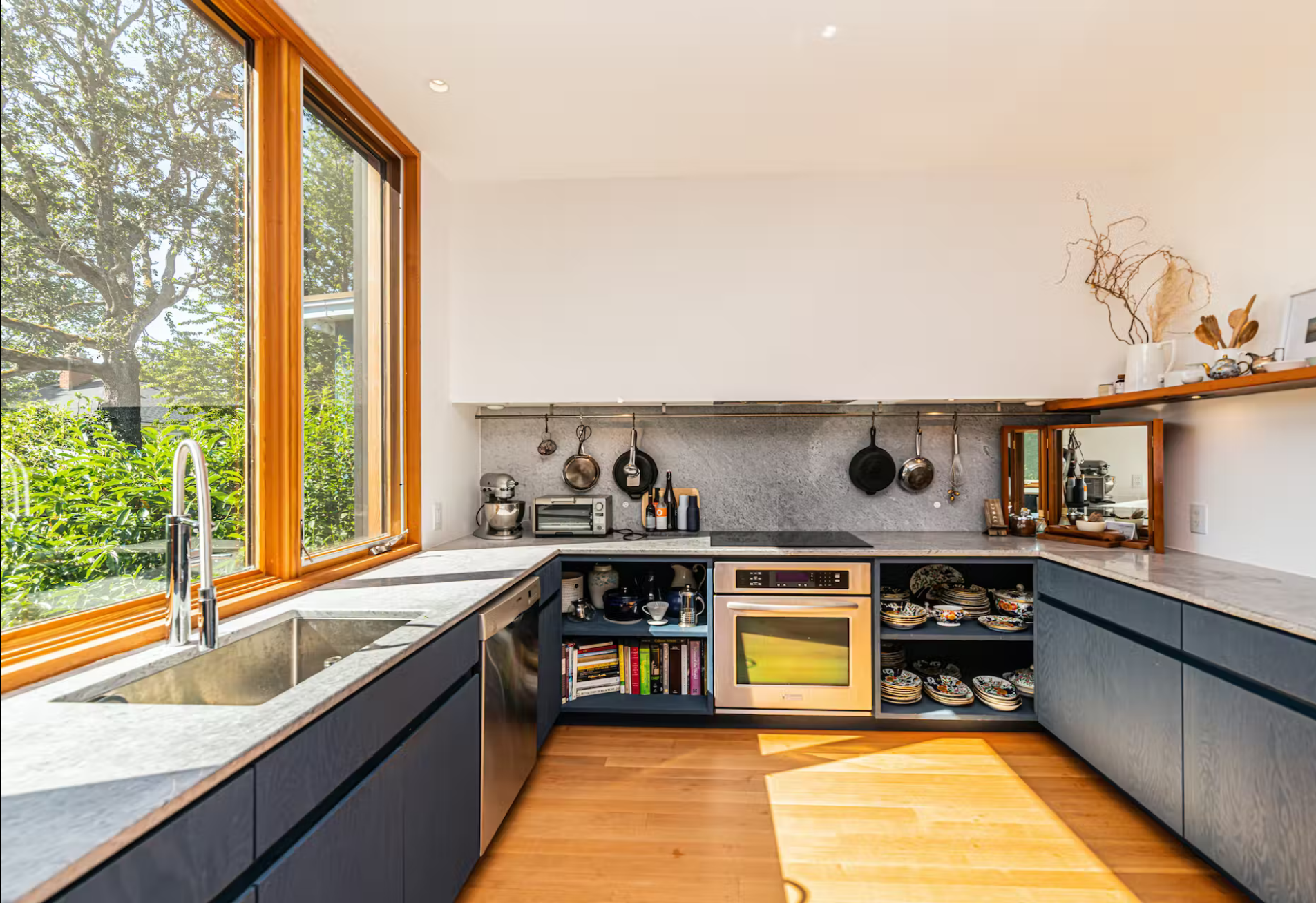
Kitchen base cabinets are marine grade plywood stained blue. Appliances are all used, a $1,700 investment that would have exceeded $12,000 new. The stone counters are locally quarried Tlupana blue gray marble. The range is electric, with an induction cooktop. A stainless steel rail holds pots and pans.
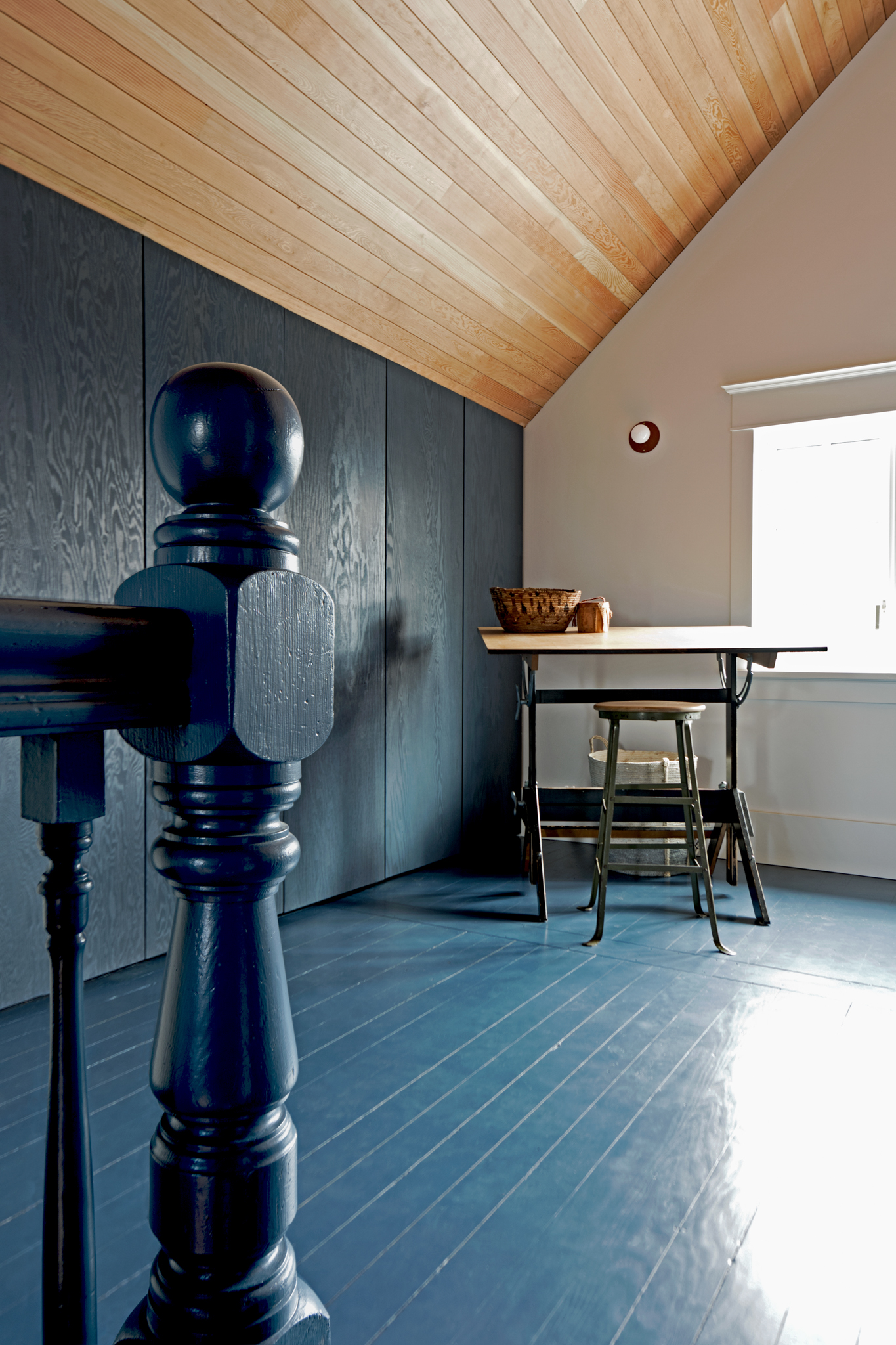
The drafting table was from an art school in town, c. 1930s. The original floors were patched and painted, and the marine-grade plywood wall to the left houses three closets. (“A beautiful way to make messes disappear,” said Wendy Littlefield). The fir ceiling came from a tear-down nearby.
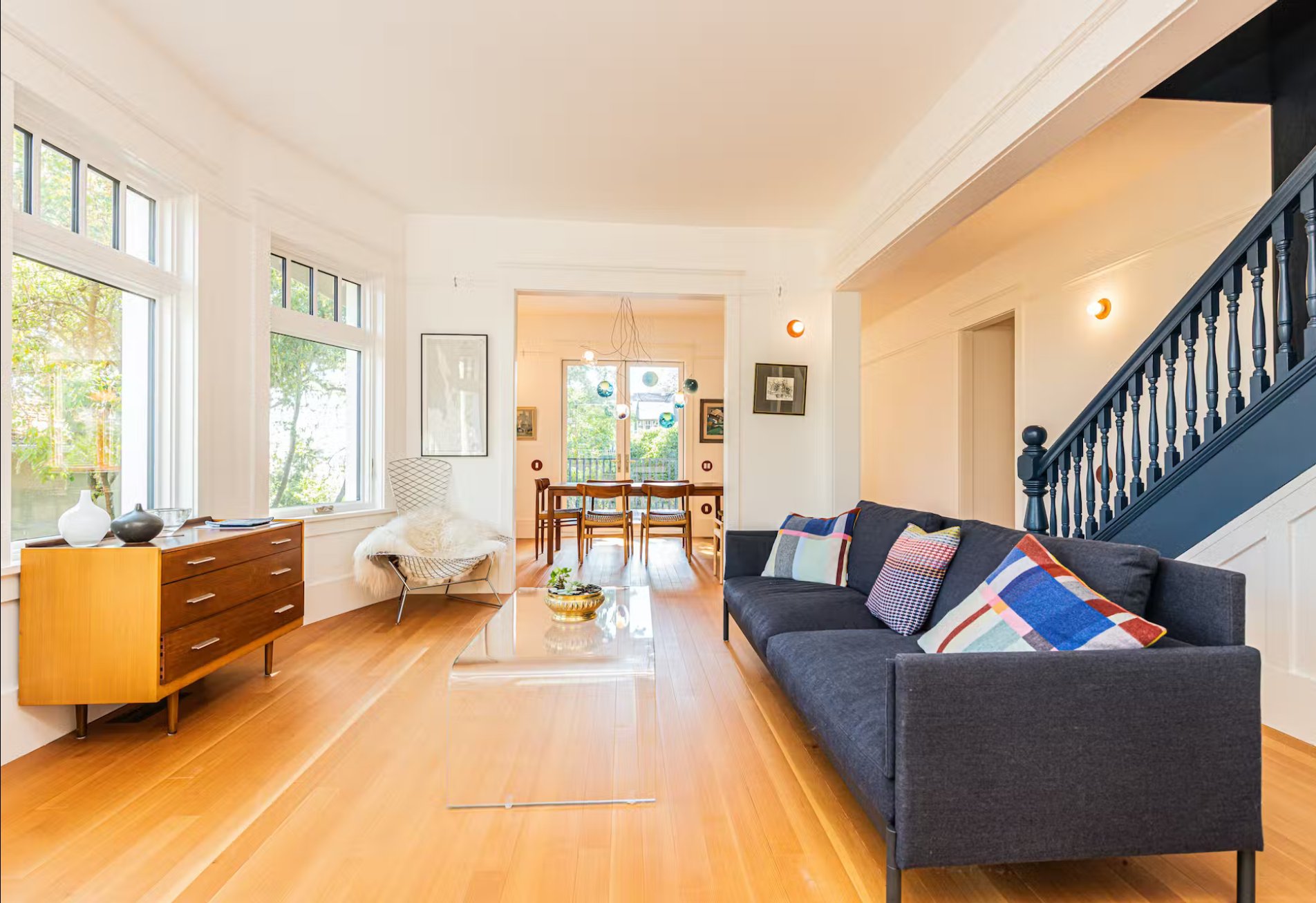
Floors were finished with Saicos, an all natural, vegetable oil-based stain made with carnuba wax. “It’s an awesome product,” said builder Taylor McCarthy. “Scratches are very easy to fix—you don’t have to sand the entire floor.”
The custom sofa by Scott & Scott is one of the few pieces not from an auction or secondhand store. It was made by Nathan Martell of Part & Whole. Wendy Littlefield likes the modern touch in the mix of old and new. Paint throughout the home is Farrow & Ball.

Glass door knobs, discarded during a redesign of of the Littlefields’ 1931 Robert De Golyer–designed Chicago apartment building, found a home in Fernwood. Architect David Scott created new leather rosettes.
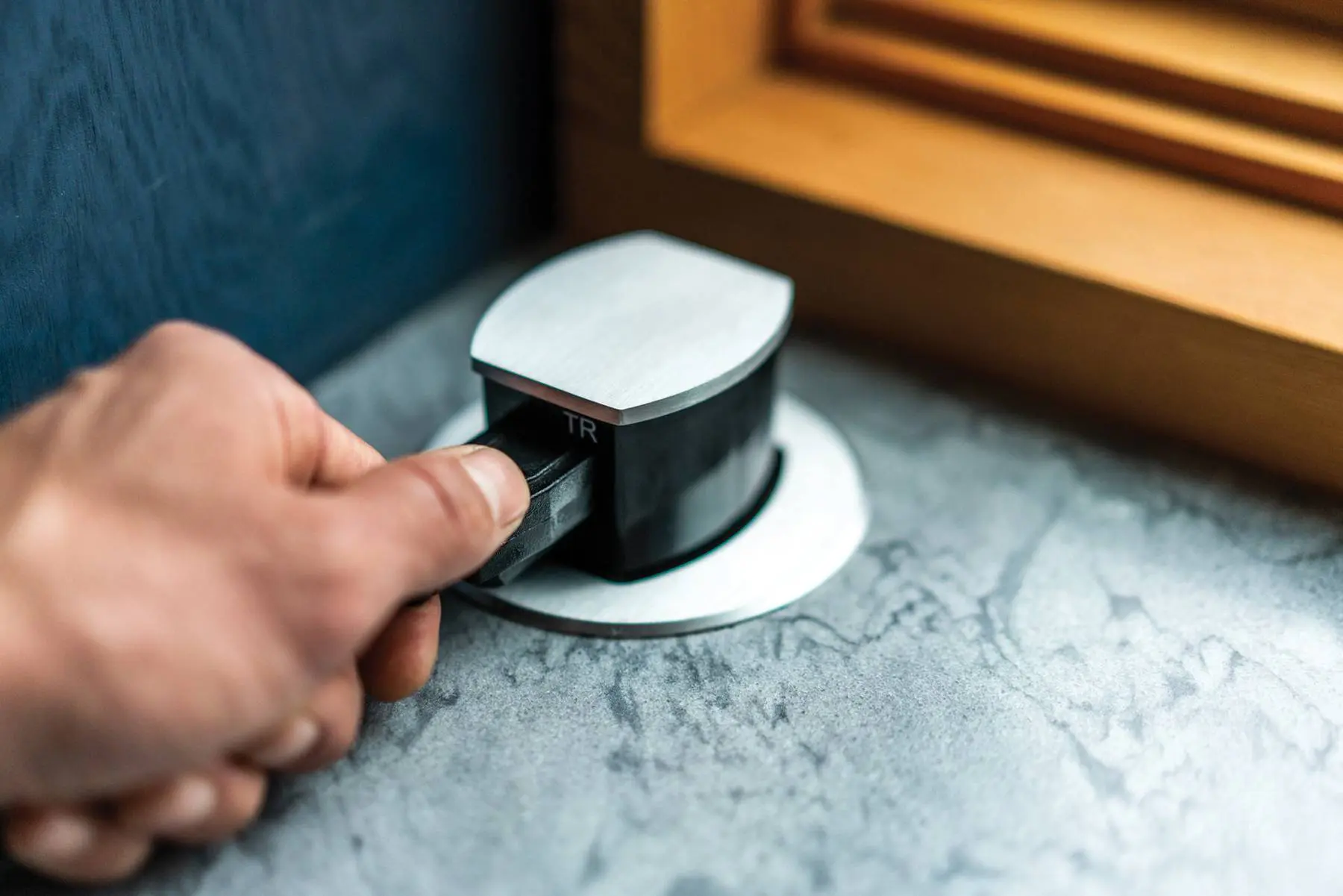
Electrical plugs were installed 6 feet apart per code, including a pop-up plug under a large window.

Cedar and fir siding and decking show a range of cuts: board and batten, tongue in groove, shadow line, trim board, belly board, barge board. The shingles are 5.5 inches.
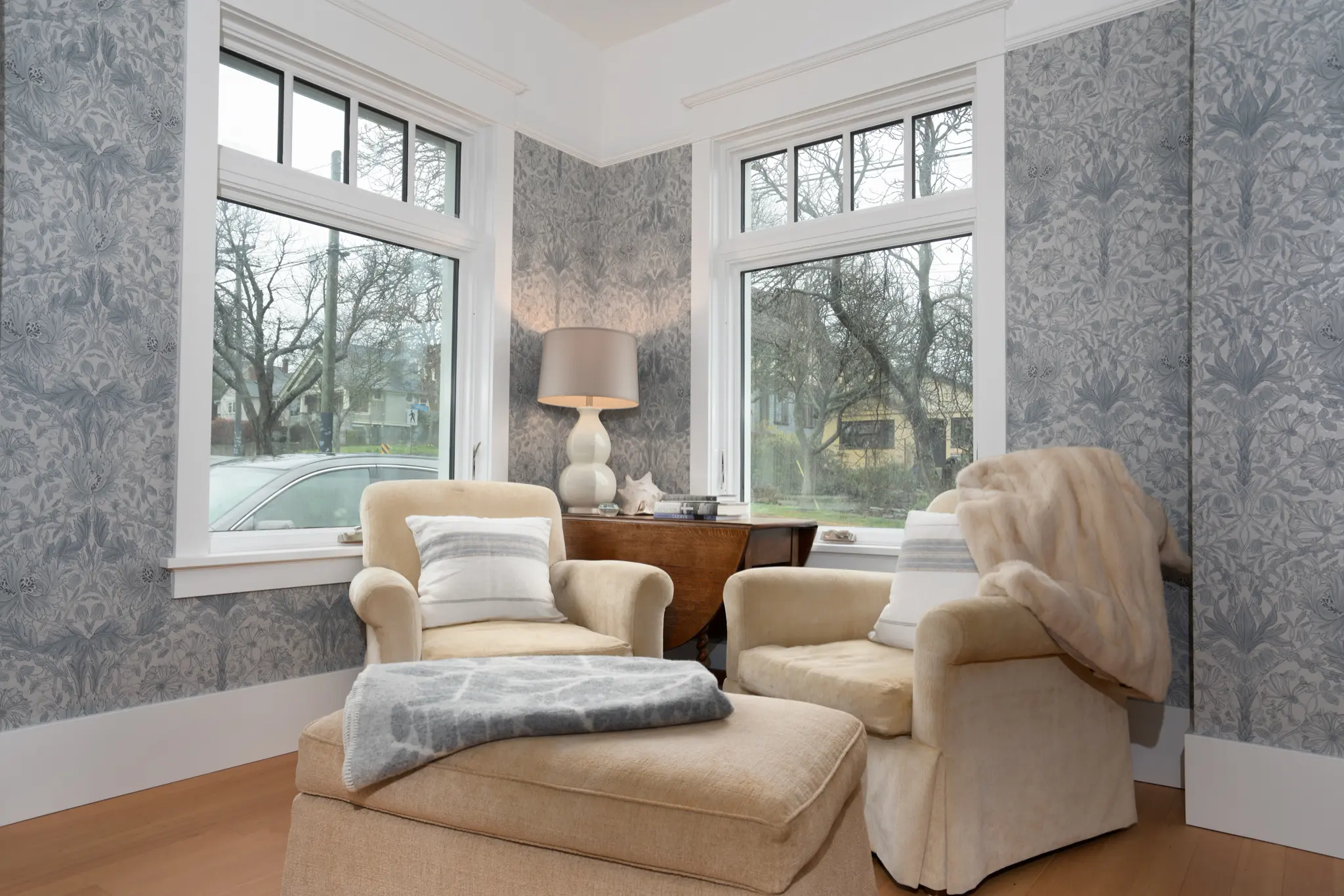
Don Feinberg bought his wife a white mink coat at auction. She had it repurposed into a luxe lap blanket.
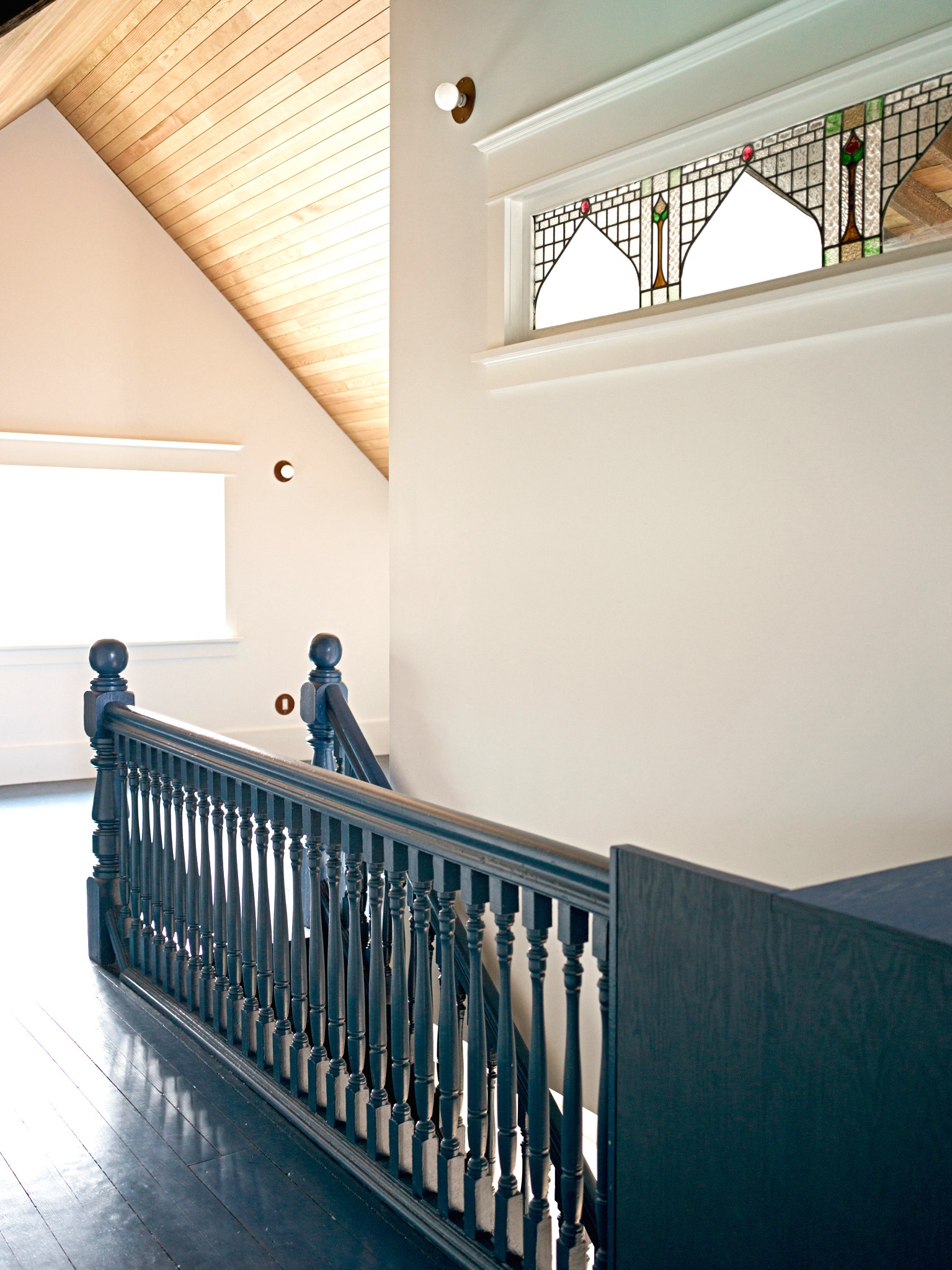
A pair of leaded glass panes were a $200 auction purchase. Wendy Littlefield later learned came from a demolished home just blocks away. The leaded glass is appreciated as a decorative object, while it allows light to travel through the space.
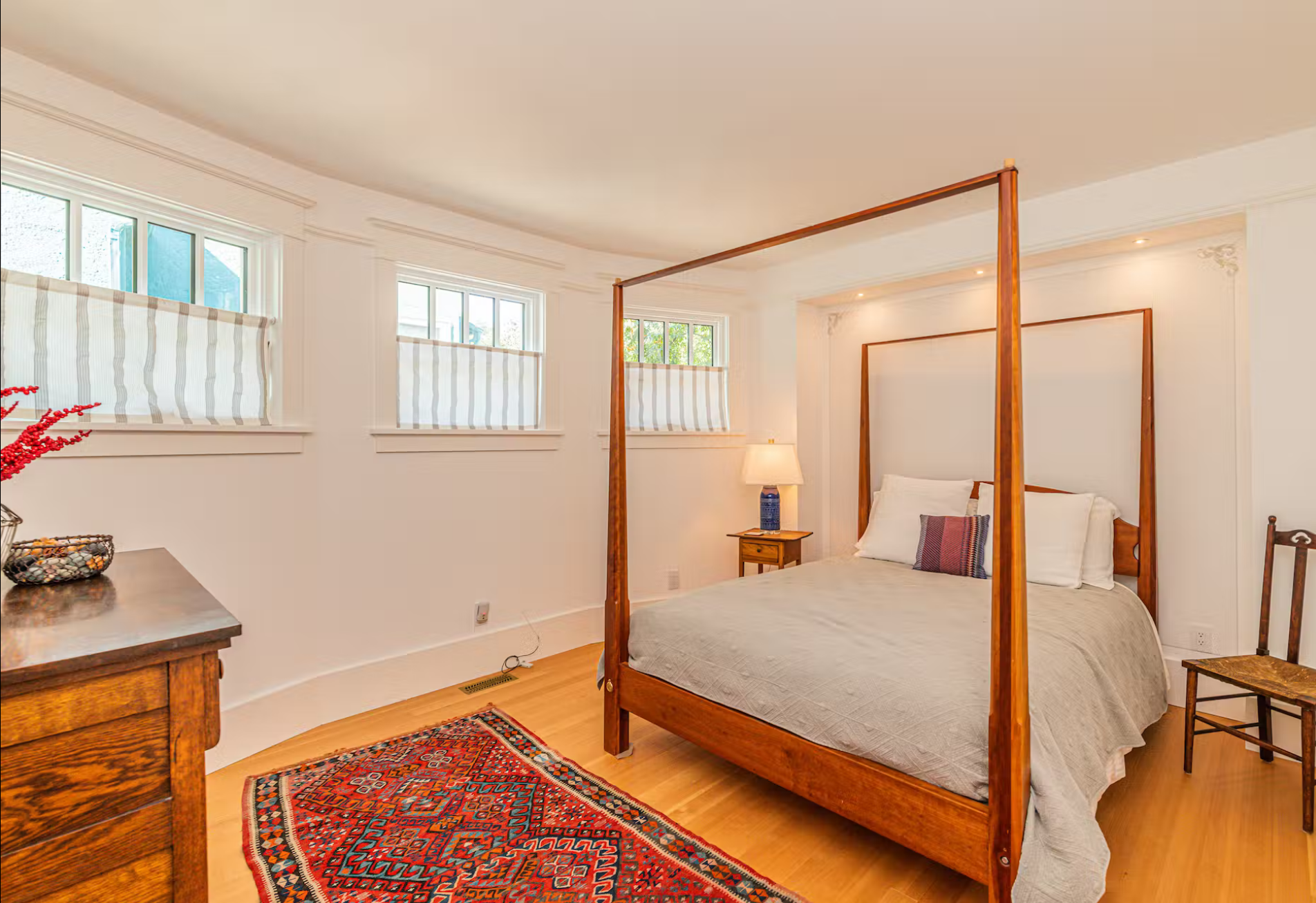
The reproduction pencil post bed was a steal for $200 and the rug $50 from an auction house.
An old home made new
There are a number of custom touches. “Our studio often makes certain elements by hand—things you touch daily,” said Scott. “The electrical switchplates and lampholders were made with remnant leather. The glass door knobs are from Wendy and Don’s apartment building in Chicago; we made the rosettes for the re-tooled door knobs. Brass heat grilles have a fern motif. The front door has brass facing that’s etched in a similar pattern to the air vents.”
Most of the furnishings are finds from thrift stores and auction houses. “I come from a long line of inveterate thrift shoppers,” said Littlefield . A spectacular glass chandelier in the dining room, a second from local factory Bocci, is an acquisition from the brand’s yearly sale.
The couple settled in for the next chapter in their lives. They would have happily stayed in Victoria but for family matters drawing them to Chicago. “We love the house,” Littlefield said both proudly and wistfully. “We’ve given it another 100 years of life and it costs nothing to operate.” The two left it in good hands: a “very progressive” young professional couple “who understand the spirit of the house” and want to raise a family there.
But Littlefield and Feindberg’s net zero journey doesn’t end in Victoria. They’re doing it again.
Armed with firsthand experience and exhaustive research, they now know how to find what they need. They’ve purchased a 1925 brick bungalow attributed to architect Andrew Norman in the Andersonville neighborhood of Chicago. They have an architect. Their new electric car is plugged in. And they’re ready to go!


